Areas of study in biology
Science is the study of the physical, material and living world.
Biology is the study of living things.
Areas of biological study include:
- Botany - the study of plant life
- Zoology - the study of animals and animal life
- Microbiology - the study of microorganisms which are too small to be visible by the naked eye. Microbiology includes sub-disciplines such as virology, bacteriology, mycology, immunology and parasitology
- Anatomy - focuses on the study of the overall structure of the body viewed using the dissection of parts of the body
- Physiology - focuses on the normal functions of living organisms and aims to understand their mechanisms and how they work and interact
- Ecology - the study of organisms and how they interact in their environments
- Genetics - the study of genes, inheritance and variation in living organisms
- Taxonomy - is concerned with the classification, identification and naming of organisms. It is a system of organising plants and animals into groups that share similar qualities
- Cytology - the study of the individual cells of living organisms.
Scientific method
Scientists use the scientific method to collect measurable data and evidence to support or contradict a scientific theory. The process involves observing, asking questions, and seeking answers through tests and experiments, and is applied in all fields of science.
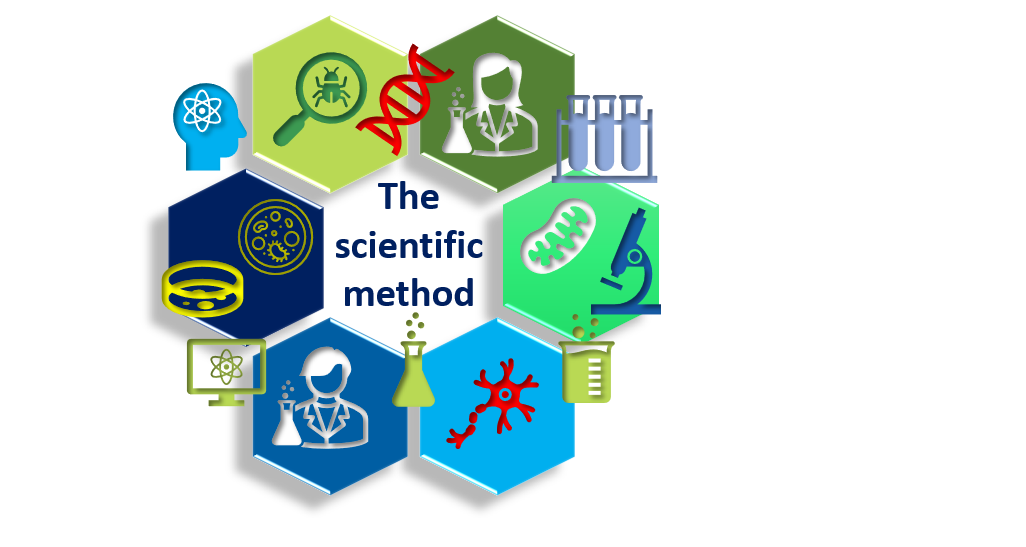
The steps in the science method have been employed by scientists since the 17th century. In 1796 Edward Jenner observed that milkmaids working with cows never got smallpox, but they did get the milder disease, cowpox. He guessed that exposure to cowpox could be used to protect against smallpox. This hypothesis eventually led to the development of world's first vaccine.
Steps of the scientific method
The scientific method is used by scientists using a step by step process. Understanding the steps of the scientific method, helps you focus your ideas, observations and scientific questions. It helps you to work through your observations for experimentation, analyse your results data, and hopefully be able to answer your original questions.
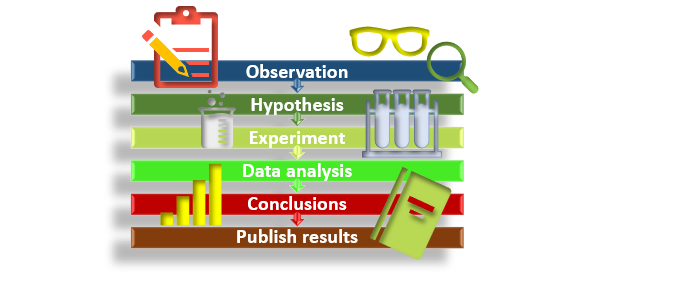
Observation
Observation is an unbiased, accurate report of an event. Observations may be made directly using our senses e.g., seeing and hearing, or indirectly using equipment e.g., microscopes or thermometers.
Constructing a hypothesis
A Hypothesis is an 'educated guess' and proposes a possible explanation, based on observations, about how things work in the natural world. It is an attempt to answer a question with an explanation that can be tested.
A good hypothesis allows you to then make a prediction.
"If...(I do this).....then....(this)....will happen".
Example: "If the amount of fertilizer applied to plants is increased, then plant growth will increase".
Experimenting to test a hypothesis
An experiment is designed to test a hypothesis. It will show whether a prediction is accurate and if the hypothesis can be supported or not. It is important the experiment is a fair test. A fair test is conducted by making sure that only one factor is changed at a time, while keeping all other conditions the same.
Analysing the data
Data in the form of results, measurements, observations or information is gathered during an experiment and then analysed to see if they support the hypothesis or not. Graphs, tables and statistical analysis are used to present the data in the most logical manner possible.
Drawing conclusions
Conclusions are when the data is interpreted to show if a hypothesis is true or false. Scientists often have to repeat experiments or construct a new hypothesis based on the information they learned and how it relates to exisiting knowledge.
If a hypothesis is confirmed, they will test further with new experiments or observations, due to the need for consistent and accurate results. If a hypothesis is unconfirmed, then they will change the hypothesis and design new tests.
Publishing and communicating the results
It is important for scientists to publish results and to write a report on their findings, so that experiments can be repeated. Results can be analysed, and ideas made available to all scientists, which in turn adds to the growth of scientific understanding. Results can be published in journals, magazines, newspapers and on the internet.
A theory is an explanation based on repeated hypotheses and experimentation.
A principle or law is a theory that becomes valid against long-term testing.
Principles of experimentation
Experiments are scientific investigations performed under controlled conditions, usually in a laboratory.
An experiment is carried out to support or refute a hypothesis.
A hypothesis is a proposed explanation or solution for an observation made. You must be able to test your hypothesis and to prove if it is true or false.
Experiments include the following:
- Careful planning and design - starting with an observation and hypothesis
- Control experimentation - use standard comparisons to judge results against
- Fair procedures - a fair test is changing only one factor at a time, and keeping other conditions the same
- Safe procedures - understanding laboratory safety and the use of safety equipment.
Careful planning and design
Experiments need to be carefully planned and designed. They start with an observation that can be made into a hypothesis. From there an experiment is designed and planned to explore the hypothesis.
Example - seedlings growing towards the light
- Observation – you notice that seedlings bend as they grow towards the light
- Hypothesis – "If there is a source of light coming from one side, then the seedlings will grow towards it"
- Design – to test this hypothesis and experiment is designed using a shoebox with two interior compartments, one with a hole on top and the other with a hole to the side, which line up to a light source. A seedling is then placed in each compartment and left to grow
- Variables - there is one variable here, light. A variable is a factor that may change in an experiment. Others variables could be a draught or temperature, but these are kept constant here by using a draught-free room at constant temperature.
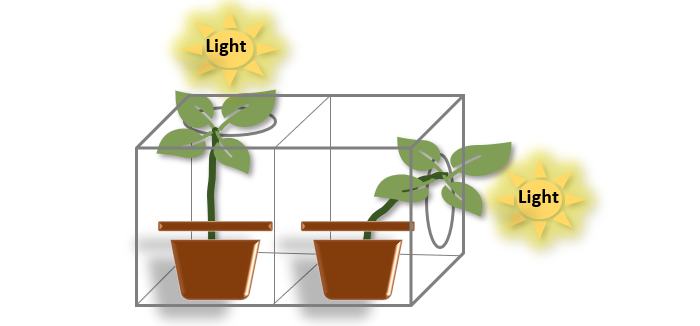
The results of this experiment show the seedlings do indeed grow towards the light. Where the light is coming from the side aperture, the stem has to bend and grow directionally towards the light - this is known as phototropism.
Control experimentation
Control experiments involve a comparison and is used to provide a standard against which the actual experiment can be judged. The control or copy experiment, differs in one variable from the real experiment.
Example 1: testing the effects of water on the sprouting of seeds
Two plant pots are filled with an identical number of bean seeds.
In the experimental group the seeds are watered daily and in the control group the seeds are not watered.
Water is therefore the independent variable in the experiment.
In the experimental group nine out of ten of the seeds sprout, however, in the control group none of the seeds sprout. Sprouting is therefore a dependent variable on the presence of water.
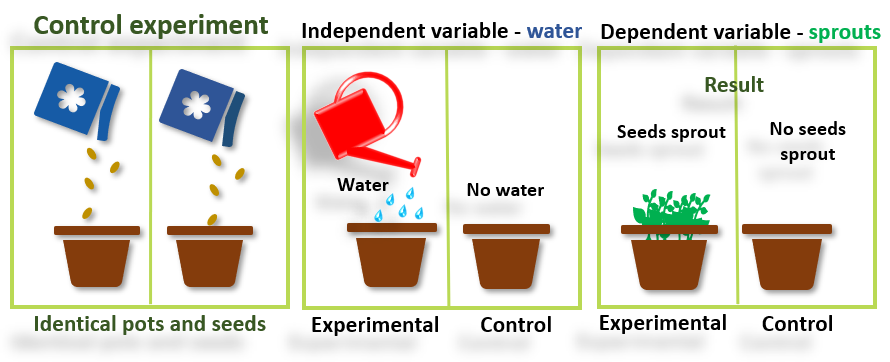
Example 2: testing the effects of an arthritis drug
A number of patients with arthritis are x-rayed and any deformities noted.
The patients are divided into the experimental group, who receive the test drug and a control group, who receive a placebo. A placebo is a fake medicine with no active properties e.g., a sugar pill.
While all variables are kept similar e.g., age, sex, etc. the only difference between the groups is the medication given.
After a six month period, both groups would be x-rayed again to look for any changes or improvements in the condition, and to see if the test drug produced any positive results.
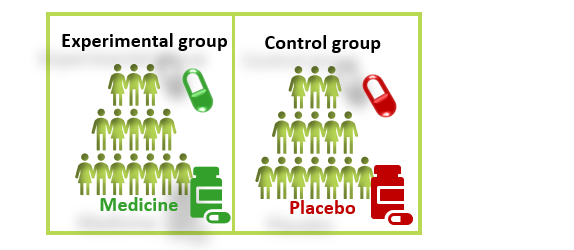
Fair tests and procedures
It is important for an experiment to be a fair test. If the test is not fair, then the results will not be accurate, and this will reduce the effectiveness of the test. You conduct a fair test by changing only one factor, known as the variable, at a time, while keeping all other conditions the same.
Scientists do this to ensure that no other variables affect the results of the test. They do repeats of the experiment to ensure that there were no unknown factors or mistakes which changed the outcome of the experiment.
Fair procedures
Scientists can use the following procedures to ensure fair testing and reliability of results:
- A large sample size produces more reliable results - for example, in the seedling experiment, it is more reliable to use a large number of seedlings. This reduces the risk that results are individual differences. In the arthritic drug test, if one person treated then recovered, it may have been due to the person recovering of their own accord whereas if hundreds of people are treated and improve, then the result is more likely to be due to the drug given.
- Random selection prevents bias or unfairness - it would not be fair to test seeds of one type in above experiment. You want to prove that results apply to all seeds. In the arthritic drug test, it would not be fair to test only females or those above 50 years of age because the results may be influenced by the factor selected.
- Others must be able to replicate the experiment - it is important to report experiments publicly so that they can be replicated or repeated.
- Double blind testing - is when neither the person being tested, or the tester should know who is receiving the real treatment or who is receiving the placebo.
Safe procedures
Before conducting experiments, it is essential to understand and follow safety procedures in the science laboratory.
Laboratory safety includes:
- Protective equipment - wear a lab coat, safety glasses and gloves when necessary
- Safety signs and symbols - be aware of the safety information for chemicals, displayed as labels on their containers
- Hygiene - never place fingers in eyes or mouth unless washed or eat in the laboratory
- Electrical safety - avoid contact between electrical equipment and water
- Report spills or accidents - report all accidents to teacher or supervisor.
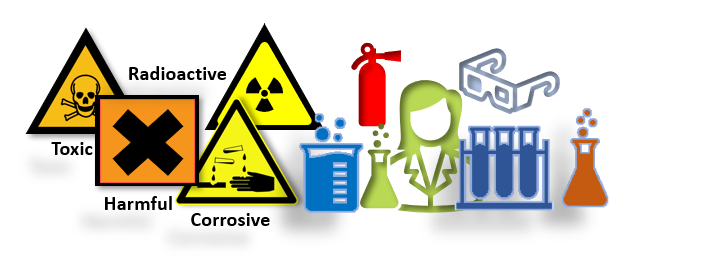
Limitations of the scientific method
The scientific method is limited by:
- The extent of our knowledge - forming a hypothesis and designing an experiment is based on what we know. Until viruses were discovered many diseases could not be explained e.g., smallpox
- Observation method and instruments - the design of experiments is limited to the range of observation methods and instruments available at the time e.g., the discovery of viruses depended on the discovery of the electron microscope
- Human error - mistakes can be made in recording observations or by using measuring instruments inaccurately
- Deliberate falsifications - the deliberate falsification of results e.g., in cases of scientific fraud
- Bias - confidence in the hypothesis can affect accuracy of observation and interpretation of results
- Ability to interpret - we may be limited by the ability to interpret the results presented in an experiment.
Wrong interpretations
Wrong interpretations can lead to wrong conclusions e.g., thalidomide was used to treat morning sickness in human pregnancy in 1950s. It was safely tested on many animals and then wrongly interpreted as safe for humans. The drug was not tested on embryos in the womb, and it caused severe birth defects such as limb deformities and organ defects in babies. The drug was withdrawn in 1961 by which time as many as 10,000 children had been affected.
Limited to the present time
What is true now may not have been true in the past or in the future e.g., penicillin used to be effective against many bacteria but now strains have evolved that are resistant to penicillin. As changes occur, scientific theories may need to be updated or revised.
Ethical and legal responsibilities
Ethics refers to our moral principles and is concerned with what is good for both individuals and society. Ethics is an important consideration in science and guides what is right or wrong in scientific investigation, practices and decisions. Ethical considerations are needed in the use of captive animals in experiments, explaining the origins of life and the way in which evolution may have taken place, issues around contraception, abortion, assisted fertilisation, cloning animals, genetic modification, freezing human sperm and embryos, the use of stem cells from embryos to form new tissues and organs, and organ transplants from animals to humans.
Accidental discoveries
Accidental discoveries have contributed enormously to the development of scientific thinking e.g., the discovery of antibiotic penicillin by Alexander Fleming in 1928. Fleming carelessly left a dish of bacteria uncovered and it became contaminated by a fungus. He noticed that the bacteria were killed in areas around the fungus. The fungus produced penicillin which killed the bacteria.
Quiz
Test your knowledge of key terms
Click to reveal the answer: